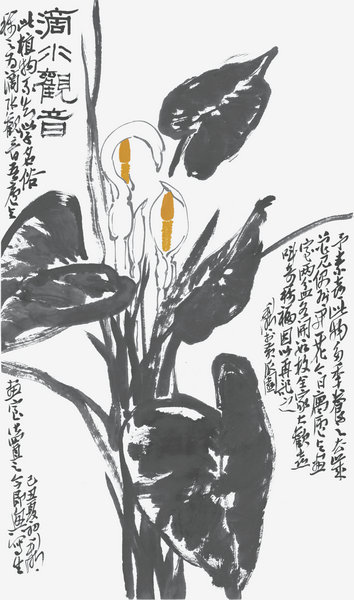 |
|
Xu Liming says calligraphy forms the foundation of Chinese aesthetics. Calligraphy remains a significant feature in his ink paintings.[Photo by Zou Hong/ China Daily] |
Master calligrapher Xu Liming underlines the importance of handwriting with his just-concluded Beijing show, Lin Qi reports.
For calligraphy master Xu Liming, 62, the presentation of Chinese characters on paper and silk is far more than technical mastery.
He says it should be a passionate process that-even if exhausting-should leave the writer thoroughly delighted. Those who have seen Xu's work will agree.
Back in his studio at the Nanjing Arts Institute in East China's Jiangsu province, where Xu teaches Chinese calligraphy to postgraduates and doctoral students, he is often seen weaving beauty on xuanzhi (traditional rice paper). He prefers rolling out the paper on the ground and then writing big characters with the rhythmic style of a dancer.
"I can work on the entire composition better only when I look down," he says in Beijing.
While creating, he sometimes pauses, turning around to accumulate more strength and throw the final stroke to complete a character. The writing process normally lasts for hours.
"It is physically challenging. But it's important to finish the whole piece of work in one breath with stability."
Xu's works have helped him to connect with master calligraphers of the past. A video showing his approach was played on a TV screen installed at his recent exhibition at the National Museum of China in Beijing, impressing the audience during the National Day holiday week that began on Oct 1.
Twenty-two years after his debut show at the same museum, Xu's second exhibition, which ended on Sunday, displayed dozens of scrolls in different calligraphy styles, especially the caoshu (cursive script) he specializes in. Many of his floor-to-ceiling works were also on display.
Other than ink works, including paintings, the show exhibited stamps of Xu's seals-he is a trustee of the time-honored Xiling Seal Art Society based in Hangzhou, Zhejiang province.
The exhibition, he says, also helped to tell his fans and fellow calligraphers: "Although I'm aging, I keep progressing in calligraphy."
Xu's message for modern viewers, who prefer typing over writing with pen and paper, is that penmanship isn't outdated but a practice that must be continued to endure the changes of time.